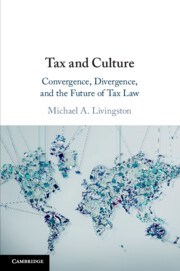Book contents
- Tax and Culture
- Tax and Culture
- Copyright page
- Contents
- Acknowledgments
- 1 Introduction: Comparative Law and Its Relevance to the Tax Field
- 2 Tax Anthropology: Attitudes, Behaviors, and the Role of Historical Contingencies
- 3 Tax Sociology: The Significance of Tax Institutions
- 4 Convergence, Divergence, and the Persistence of National Differences
- 5 Case Studies I: The Tax Cultures of Selected Western and Non-Western Countries
- 6 Case Studies II: Progressivity, Tax Avoidance, and Environmental Taxes
- 7 Conclusion: The Limits of Globalization and the Continuing Importance of Culture
- Index
3 - Tax Sociology: The Significance of Tax Institutions
Published online by Cambridge University Press: 13 March 2020
- Tax and Culture
- Tax and Culture
- Copyright page
- Contents
- Acknowledgments
- 1 Introduction: Comparative Law and Its Relevance to the Tax Field
- 2 Tax Anthropology: Attitudes, Behaviors, and the Role of Historical Contingencies
- 3 Tax Sociology: The Significance of Tax Institutions
- 4 Convergence, Divergence, and the Persistence of National Differences
- 5 Case Studies I: The Tax Cultures of Selected Western and Non-Western Countries
- 6 Case Studies II: Progressivity, Tax Avoidance, and Environmental Taxes
- 7 Conclusion: The Limits of Globalization and the Continuing Importance of Culture
- Index
Summary
If attitudes form the foundation of tax culture, institutions form its structure. Indeed, a tax itself is a sort of institution, which is created by other institutions (primarily legislatures) and, in turn, requires further institutions to enforce and monitor it. As observed in Chapter 1, institutions are created in response to popular attitudes and, in turn, mold those attitudes, so that it is sometimes hard to determine where one ends and the other begins.
- Type
- Chapter
- Information
- Tax and CultureConvergence, Divergence, and the Future of Tax Law, pp. 32 - 49Publisher: Cambridge University PressPrint publication year: 2020

